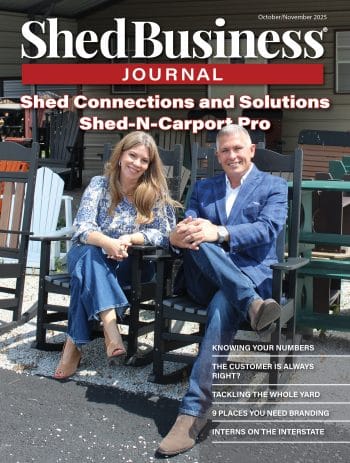
Does your shed business have photos, blogs, or even product patents that need to be protected from usage infringement?
What is intellectual property (IP)?
In business, including the shed-building industry, the most common intellectual property involves brand trademarks, copyrights on creative expressions (marketing copy, photos, etc.), and patents on new inventions.
As a shed business owner, it’s important to maintain control of your brand, your creative works, and any invention patents you may have. You also need to be sure that you aren’t infringing on the IP rights of other businesses.
The recent National Federation of Independent Business (NFIB) webinar “IP Basics for Small Business: How to Identify and Protect Intellectual Property” explored how business owners like yours can protect their IP rights (and avoid violating the rights of others).
Steven Tepp and David Newhoff, co-founders of RightsClick, and Will Boychuck, founder of Koppa Brand Protection, led the discussion.
“Each of the types of intellectual property protects a different aspect of a product, and you can have more than one form of IP protection in the same product,” says Tepp. “The example is a tube of skin cream. The logo and the name of the company is the trademark, the product photo and advertisement is a copyrightable work, and it’s entirely possible that the formula for the cream itself could be patentable.
“So, in each of these cases, there’s intellectual property wrapped into the product.”
TRADEMARK
The way each form of IP works is different, Tepp shares, and how the rights of each form are secured is different.
“In the case of trademarks, you have to be using it in commerce, and you have to file with the U.S. Trademark Office, which is part of the U.S. Patent and Trademark Office,” he points out. “It requires maintenance. Every 10 years, you have to refile and pay another fee, but as long as you’re in business, your trademark can last forever.”
However, a business must be vigilant about protecting its trademarks.
“It’s important to remember that if you see an infringement of your trademark and don’t act, you could actually lose your rights over time,” Tepp points out, “because if others are using similar or confusing trademarks, that can dilute your mark and dilute your rights.”
COPYRIGHT
Tepp says that copyright, technically, is automatic.
“At the moment you create the work fixed in a tangible medium (the language of the law), the copyright exists,” he says. “But, there’s a catch. If you don’t register your copyright with the U.S. Copyright Office, then your ability to enforce your rights is severely, if not completely, curtailed.
“No maintenance is required. Once you register your copyright, it’s good for the entire life of the copyright, which is very long. If the business owns the copyright, it’s a 95-year term of protection. If it’s an individual who owns it, who created the work, it’s the life of that individual author or group of authors, plus 70 more years.”
Copyright has some of the strongest enforcement tools, Tepp shares.
“Since the advent of the Internet, copyright piracy has been something of an amateur epidemic,” he says.
“Congress has acted to provide additional tools that you can use to help protect your business.
“One of those tools is called statutory damages. Instead of having to prove exactly what you would have licensed the work for, in similar circumstances, you can just say to the court, go ahead and pick the damages from a range in the statute. That range is up to $30,000 for ordinary, run-of-the-mill infringement suits. And if the infringement was willful, and you can prove that it could be up to $150,000 for an infringement of just one work.”
He adds that copyright can work for or against you, depending on your situation.
“You may not even think of yourself as a copyright owner, but you are,” Tepp points out. “Every photo you’ve taken, if you write blogs, even an email is protected by copyright, if it’s more than a line or two.
“Knockoff scammers also commonly copy the product photos right off your website. Those photos are copyrightable, and so copyright can give you access to more enforcement tools against scammers.
“At the same time, many people don’t realize if you pull a photo off some website or just from an Internet search or put music in the background of a video, for example, you might be infringing someone else’s copyright. Then those $150,000 damages could be threatened against you. We want to help you avoid that for everyone’s sake.
“Rule one, just because it’s on the Internet does not mean it’s free. Rule two, if you’re using something that isn’t yours, especially if it’s for your business, it’s smart to make sure you have permission.”
PATENT
Protecting IP rights via patent is the most difficult, according to Tepp.
“The examination process here is the most rigorous because patents are only given for new inventions,” he points out. “We highly recommend using an attorney to help craft your patent application because the way you write the description of your invention will determine first whether or not the patent is issued and second, if it’s issued, what the scope of your rights and protection are.
“Patents are very, very strong protection but much shorter. They last for 20 years from the date you file the application.”
STEPS TO TAKE
What can a business do to prevent unapproved usage of intellectual property by another entity? First, says Boychuck, is to search for and document any IP violations.
“We use a proprietary algorithm to recursively search for indicators that may indicate infringing content,” he says. “Once we find those listings, then it’s important to document them. It’s good to make these reports, but it’s even more important down the line in case there’s legal action, or there’s anything that may come of the infringement, that we have proof that they exist.
This may take the form of downloading the webpage, taking screenshots of the webpage, as well as making test purchases. That may be very, very, very helpful down the line if you decide to take legal action or pursue the removal of particular content.
“There’s a law called the DMCA (Digital Millennium Copyright Act) where, essentially, we can go out to these platforms or marketplaces and request that the content is removed from a particular listing or particular blog, and it costs nothing. You can just send a request to get the content removed, and in many cases that’s all that’s required in order to get the listings removed.”
However, it’s important that businesses and content creators understand that the challenges can go beyond copyright violations.
“One thing that I have seen, and perhaps some have experienced, is when counterfeiters make inferior versions of your product and then sell them and try to undermine your sales,” says Newhoff. “They aggravate that situation by also sometimes using your product photos. It’s not only egregious but also it often then comes back around to the legitimate manufacturer and when the customer who bought the inferior counterfeit then calls you up and complains about the product received. So, it’s a multi-layered problem that we’ve seen in a variety of ways.”
Tepp, Newhoff, and Boychuck recommend enlisting help to secure trademarks, copyrights, and patents since the processes can be confusing and time-consuming.
“The Copyright Office website is copyright.gov, and you can do it, but the reason we exist is because that website is confusing and clunky,” Tepp points out.
“It literally takes 28 pages on the website to file a registration application. There are people who are used to doing it, and they do it.”




